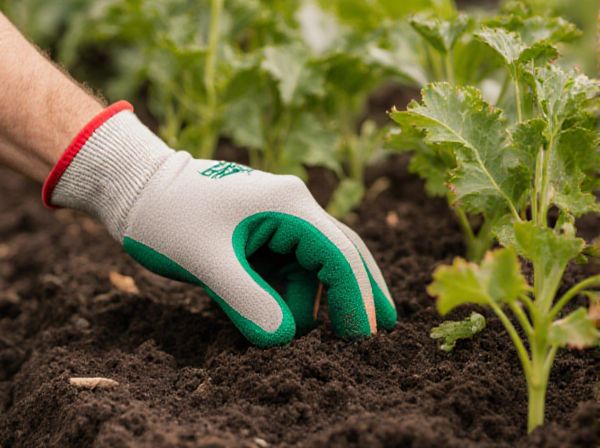
Fall Crop Planting vs Spring Crop Planting Illustration
Fall crop planting offers the advantage of cooler temperatures and reduced pest pressure, leading to robust growth and higher quality yields. Spring crop planting allows for an extended growing season and the opportunity to capitalize on early-season markets. Choosing between fall and spring planting depends on crop type, climate conditions, and market demands.
Table of Comparison
| Aspect | Fall Crop Planting | Spring Crop Planting |
|---|---|---|
| Planting Time | Late August to October | March to May |
| Soil Temperature | Cooling, 50-65degF (10-18degC) | Warming, 55-70degF (13-21degC) |
| Common Crops | Broccoli, Kale, Spinach, Carrots | Tomatoes, Peppers, Beans, Corn |
| Growth Duration | Shorter due to frost onset | Longer, full growing season |
| Water Requirements | Moderate, cooler weather | Higher, warmer weather |
| Frost Risk | High risk moving into winter | Low to moderate risk late spring |
| Yield Quality | Often sweeter, enhanced flavor | Consistent yields, larger size |
| Advantages | Extended harvest, pest reduction | Long growing season, diverse crops |
| Disadvantages | Frost damage risk, limited crop options | Soil warming delay, higher water use |
Introduction to Seasonal Crop Planting: Fall vs Spring
Fall crop planting offers cooler temperatures and increased soil moisture, promoting robust root development for vegetables like kale, broccoli, and carrots. Spring crop planting benefits from warming soil and longer daylight, accelerating germination and growth in crops such as lettuce, peas, and radishes. Understanding the distinct climate conditions and planting windows optimizes yield and crop quality in seasonal agriculture.
Key Differences Between Fall and Spring Edible Gardens
Fall crop planting involves cooler temperatures that promote the growth of hardy vegetables such as kale, broccoli, and carrots, which thrive with reduced pest pressure. Spring crop planting suits warm-season crops like tomatoes, peppers, and cucumbers that require longer growing seasons and frost-free conditions. Soil moisture levels differ as fall gardens often benefit from residual summer rain, while spring gardens depend on increasing temperatures and rainfall to jumpstart seed germination.
Best Edible Crops for Fall Planting
Fall crop planting thrives with vegetables like kale, spinach, and Brussels sprouts, which develop sweeter flavors as temperatures drop. Root crops such as carrots and beets benefit from the cooler soil, enhancing their texture and nutritional content. These cold-hardy edibles withstand frost, extending the harvest season and boosting garden productivity.
Ideal Edible Crops for Spring Planting
Spring crop planting favors cool-season edible crops like lettuce, spinach, peas, and radishes, which thrive in moderate temperatures and longer daylight hours. These crops benefit from early spring moisture and avoid the intense heat of summer, leading to optimal growth and flavor development. Selecting varieties with fast maturation rates ensures a productive harvest before summer stress impacts crop quality.
Soil Preparation Techniques for Each Season
Fall crop planting soil preparation involves deep tilling and incorporating organic matter like compost to improve soil structure and nutrient retention during winter. Spring crop planting requires light tillage and careful moisture management to create a fine seedbed, promoting quick germination and reducing soil compaction. Both seasons benefit from soil testing to adjust pH levels and targeted fertilization based on specific crop nutrient demands.
Temperature and Climate Considerations
Fall crop planting benefits from cooler temperatures and increased soil moisture, which enhance seed germination and reduce pest pressure compared to spring planting. Crops like kale, broccoli, and carrots thrive in fall as they require cooler growing conditions and can tolerate early frosts. Spring planting demands attention to soil temperature, as many seeds need warmer soils above 50degF (10degC) for optimal germination and early growth.
Pest and Disease Management: Fall vs Spring
Fall crop planting offers a strategic advantage in pest and disease management by reducing early-season pest pressure and allowing natural suppression through colder temperatures, which limits overwintering of many pests and pathogens. Spring crop planting, however, faces higher initial pest infestations and disease risks due to warmer, moist conditions that favor rapid pest reproduction and pathogen development. Integrating crop rotation and resistant varieties in fall planting systems enhances disease resistance, while spring planting demands vigilant monitoring and timely interventions to control emerging pest populations.
Harvest Times and Yields Comparison
Fall crop planting generally results in earlier harvest times due to cooler temperatures slowing plant growth less than freezing conditions, allowing for a steady maturation period before winter. Yields from fall planting often surpass spring planting, as crops benefit from extended growing seasons and reduced pest pressure. Crops like spinach, kale, and carrots typically produce higher quality and quantity in fall compared to spring.
Succession Planting Strategies for Year-Round Harvests
Succession planting strategies in fall and spring crop planting optimize year-round edible harvests by staggering sowing times to maximize yield and resource use. Fall planting cool-season crops like kale and carrots complements spring planting of warm-season vegetables such as tomatoes and beans, ensuring continuous edible produce. Employing crop rotation and cover cropping within these succession schedules enhances soil fertility and pest management for sustainable yields.
Tips for Maximizing Success in Both Fall and Spring Gardens
Fall crop planting benefits from selecting cold-tolerant vegetables like kale, carrots, and Brussels sprouts, ensuring soil is well-amended with organic compost for nutrient retention. Spring crop success relies on early soil warming, precise timing of frost dates, and planting fast-growing seeds such as lettuce, peas, and radishes to maximize yield. In both seasons, consistent watering, pest monitoring, and using row covers protect tender seedlings and extend the growing period for higher productivity.
Fall Crop Planting vs Spring Crop Planting Infographic

 gardendif.com
gardendif.com